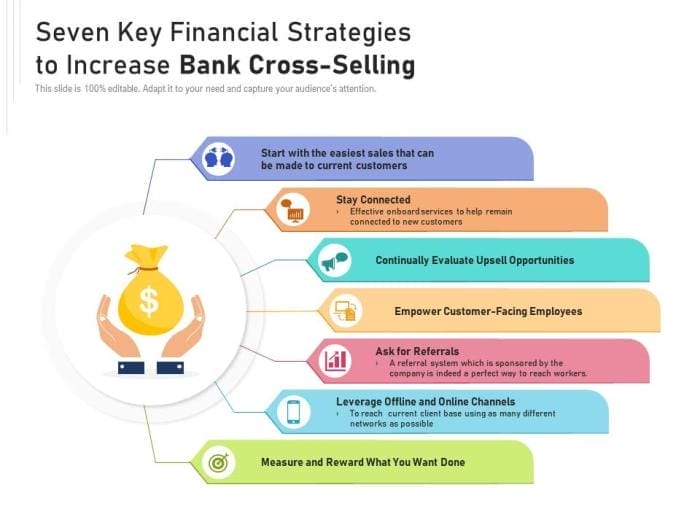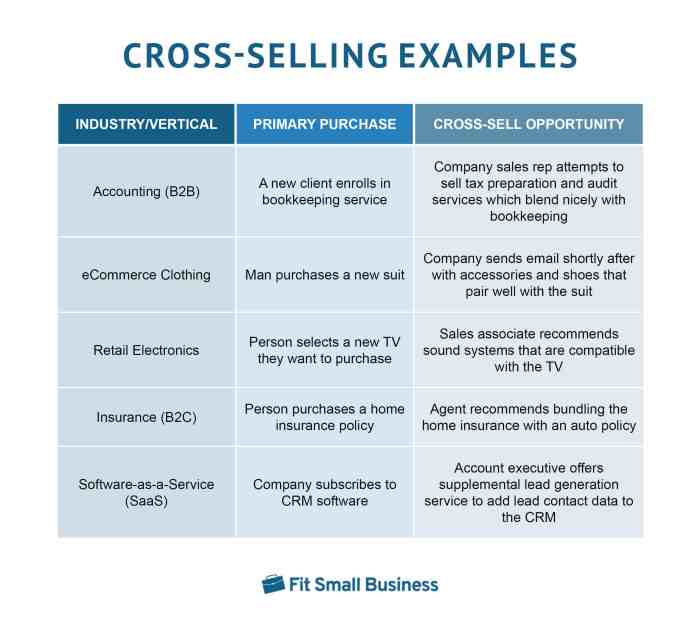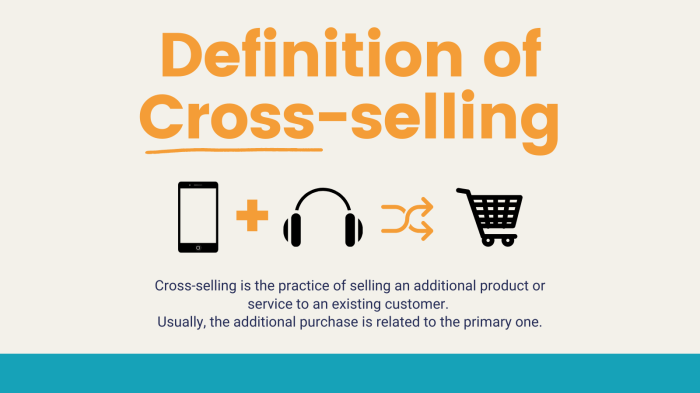In the ever-evolving financial landscape, cross-selling insurance has emerged as a strategic approach to enhance customer satisfaction, increase revenue streams, and strengthen institutional growth. This guide delves into the art of cross-selling insurance within financial institutions, providing practical tips and insights to help you unlock the full potential of this powerful sales technique.
Cross-selling insurance presents a win-win situation for both institutions and customers. Institutions can diversify their product offerings, deepen customer relationships, and boost profitability. Customers, on the other hand, benefit from tailored insurance solutions that meet their evolving needs, ensuring comprehensive financial protection and peace of mind.
Understanding Cross-Selling Insurance

Cross-selling insurance is a strategic approach employed by financial institutions to offer additional insurance products to their existing customers. It involves leveraging the existing customer base to introduce complementary insurance policies that align with their financial needs and goals.Cross-selling insurance offers several benefits for both the institution and its customers.
Financial institutions can diversify their revenue streams, enhance customer retention, and strengthen customer relationships by providing a comprehensive suite of insurance products. Customers, on the other hand, benefit from the convenience of accessing a variety of insurance options from a trusted provider, the potential for premium discounts and bundled benefits, and the opportunity to tailor their insurance coverage to their specific requirements.There
are numerous types of insurance products that can be cross-sold, including life insurance, health insurance, auto insurance, homeowners insurance, and travel insurance. Each type of insurance serves a unique purpose and can provide valuable protection and peace of mind to customers.
Identifying Cross-Selling Opportunities

Spotting potential cross-selling opportunities among your existing customers is a crucial step in maximizing insurance sales and boosting revenue. Here’s how you can effectively identify these opportunities:
Customer Data Analysis
Analyzing customer data is a goldmine for identifying cross-selling prospects. By delving into customer records, you can gain valuable insights into their insurance needs and preferences. This data can include information such as:
- Personal information: age, marital status, number of dependents, occupation, and income.
- Financial information: assets, liabilities, and investment portfolio.
- Insurance policies: types of insurance, coverage limits, and premium amounts.
- Claims history: types of claims filed, frequency, and amounts.
Understanding Customer Demographics and Financial Profiles
Understanding customer demographics and financial profiles is essential for tailoring cross-selling strategies. Different customer segments have unique insurance needs and preferences. By segmenting customers based on factors such as age, income, and lifestyle, you can develop targeted cross-selling campaigns that resonate with each segment.
Building Customer Relationships
Establishing strong customer relationships is pivotal for successful cross-selling in the financial industry. When customers feel valued and understood, they are more likely to trust your recommendations and consider additional products or services. Building rapport and trust is a gradual process that requires dedication and genuine care for your customers’ financial well-being.
Developing Trust and Rapport
To build trust and rapport with customers, it’s essential to:
- Be genuine: Show genuine interest in your customers’ financial goals and concerns. Ask thoughtful questions, listen attentively, and demonstrate empathy.
- Be knowledgeable: Stay updated on financial products and services, industry trends, and market conditions. Your expertise will inspire confidence in your customers.
- Be transparent: Provide clear and straightforward explanations about products and services. Avoid jargon and technical terms that may confuse customers.
- Be responsive: Respond promptly to customer inquiries and requests. Demonstrate that you value their time and are committed to providing excellent service.
Effective Communication and Active Listening
Effective communication and active listening are crucial for building strong customer relationships. When communicating with customers:
- Use clear and simple language: Avoid financial jargon and technical terms that may confuse customers. Use plain English that is easy to understand.
- Be patient and attentive: Give customers ample time to express their needs and concerns. Avoid interrupting or rushing them.
- Ask open-ended questions: Encourage customers to share their financial goals, concerns, and aspirations. Open-ended questions promote deeper conversations and help you better understand their needs.
- Summarize and confirm: Periodically summarize what you’ve heard to ensure you understand their needs accurately. This demonstrates your attention to detail and commitment to providing tailored solutions.
Creating a Cross-Selling Culture

Establishing a cross-selling culture is crucial for the success of cross-selling initiatives within a financial institution. It involves fostering a mindset among employees where cross-selling is viewed as an integral part of their daily activities and a way to provide holistic financial solutions to customers.
The culture of cross-selling is built on the foundation of understanding customer needs and proactively recommending suitable products and services that align with those needs. It requires a shift from a product-centric approach to a customer-centric approach, where employees are empowered to engage in meaningful conversations with customers to identify their financial goals and objectives.
Role of Leadership
Leadership plays a pivotal role in promoting a cross-selling mindset within the financial institution. Senior leaders must demonstrate their commitment to cross-selling by incorporating it into the organization’s strategic goals and objectives. They should communicate the importance of cross-selling to employees, emphasizing its benefits for both customers and the institution.
- Articulate a clear vision for cross-selling and communicate it effectively to all employees.
- Set measurable cross-selling goals and track progress regularly.
- Recognize and reward employees who excel in cross-selling.
Training and Motivation
Effective training programs are essential for equipping employees with the knowledge and skills necessary for successful cross-selling. These programs should cover topics such as identifying customer needs, product knowledge, and effective communication techniques.
- Provide comprehensive training on cross-selling techniques and strategies.
- Encourage employees to attend industry conferences and workshops to stay updated on the latest trends and best practices.
- Offer incentives and rewards to motivate employees to actively engage in cross-selling.
Implementing a Cross-Selling Strategy

Implementing a cross-selling strategy involves careful planning, execution, and monitoring. To achieve success, financial institutions must follow a structured approach that aligns with their overall business goals and customer needs. This section Artikels the key steps involved in developing and implementing a comprehensive cross-selling strategy.
Setting Clear Goals and Objectives
Defining clear goals and objectives is crucial for a successful cross-selling strategy. These goals should be specific, measurable, achievable, relevant, and time-bound (SMART). They should align with the overall business strategy and address specific cross-selling targets. For instance, a goal could be to increase cross-selling revenue by 15% within a year.
Developing a Comprehensive Cross-Selling Plan
A comprehensive cross-selling plan provides a roadmap for achieving the desired goals and objectives. It should include the following elements:
- Target Market: Identify the customer segments that are most likely to be interested in additional products or services.
- Product and Service Offerings: Determine the products and services that will be cross-sold, ensuring they complement each other and meet customer needs.
- Cross-Selling Channels: Specify the channels through which cross-selling will take place, such as in-person meetings, phone calls, online platforms, or mobile apps.
- Sales Process: Develop a structured sales process that Artikels the steps involved in cross-selling, from identifying potential customers to closing the sale.
- Incentives and Rewards: Consider offering incentives or rewards to employees who successfully cross-sell products or services.
- Performance Monitoring: Establish a system for monitoring the performance of the cross-selling strategy, including metrics such as cross-selling ratio, average revenue per customer, and customer satisfaction.
Personalizing Cross-Selling Recommendations

Personalizing cross-selling recommendations is crucial for meeting individual customer needs and enhancing the overall customer experience. By tailoring insurance recommendations to each customer’s unique circumstances, financial institutions can increase the relevance and effectiveness of their cross-selling efforts.
Gathering Customer Information
The first step in personalizing cross-selling recommendations is to gather comprehensive customer information. This includes demographic data, financial information, insurance coverage details, and lifestyle preferences. Financial institutions can collect this information through various channels, such as customer surveys, online forms, and conversations with financial advisors.
Understanding Customer Needs and Circumstances
Once customer information is gathered, it is essential to analyze and understand each customer’s needs and circumstances. This involves identifying their financial goals, risk tolerance, and insurance coverage gaps. Financial institutions can use data analytics tools and techniques to segment customers into different groups based on their unique characteristics and needs.
Tailoring Insurance Recommendations
With a deep understanding of customer needs and circumstances, financial institutions can tailor insurance recommendations that are relevant and beneficial to each customer. This may involve recommending specific insurance products, such as life insurance, health insurance, or property insurance, that address the customer’s specific risks and financial goals.
Financial institutions can also provide customized advice on how to structure and manage insurance policies to optimize coverage and minimize costs.
Handling Objections and Concerns

Cross-selling insurance involves addressing common objections and concerns from customers. Handling these concerns effectively is crucial for building trust and maintaining a positive customer relationship. It’s essential to maintain a professional and empathetic approach when responding to customer concerns.
Common Objections and Concerns
Customers may express various objections or concerns regarding cross-selling insurance. These may include:
- Lack of Understanding: Customers may not fully comprehend the benefits or necessity of the recommended insurance product.
- Financial Constraints: Customers may express concerns about the affordability of additional insurance products.
- Fear of Unnecessary Products: Customers may perceive cross-selling as an attempt to sell them unnecessary products or services.
- Previous Negative Experiences: Customers may have had negative experiences with insurance companies or products in the past.
Effectively Addressing Objections
To effectively address customer objections, financial institutions can consider the following tips:
- Active Listening: Genuinely listen to customer concerns and demonstrate empathy towards their perspective.
- Personalized Approach: Tailor the response to the specific needs and circumstances of the customer.
- Clarity and Transparency: Provide clear and transparent information about the insurance product, its benefits, and the associated costs.
- Highlight Value Proposition: Emphasize how the recommended insurance product aligns with the customer’s financial goals and provides valuable protection.
- Real-Life Examples: Share real-life examples or case studies to illustrate the benefits of the insurance product.
- Address Misconceptions: Correct any misconceptions or misunderstandings that the customer may have about the insurance product or the cross-selling process.
Maintaining a Positive and Professional Attitude
Throughout the cross-selling process, maintaining a positive and professional attitude is crucial. This includes:
- Approachability: Create a welcoming and approachable environment where customers feel comfortable discussing their concerns.
- Patience and Understanding: Exercise patience and understanding when dealing with customer objections, even if they appear unreasonable.
- Non-Judgmental Approach: Avoid making judgments or assumptions about the customer’s financial situation or knowledge.
- Professional Demeanor: Maintain a professional demeanor, even in challenging situations.
- Positive Language: Use positive and reassuring language when communicating with customers.
Measuring Cross-Selling Performance
Assessing the effectiveness of a cross-selling strategy is crucial for financial institutions to optimize their sales efforts and enhance customer satisfaction. Measuring cross-selling performance enables institutions to identify strengths, weaknesses, and areas for improvement, ensuring a data-driven approach to refining their cross-selling initiatives.
Key Metrics for Measuring Cross-Selling Success
- Cross-Selling Ratio: Calculated as the number of customers who purchase multiple products or services divided by the total number of customers. A higher ratio indicates successful cross-selling efforts.
- Average Number of Products per Customer: This metric measures the average number of products or services held by each customer. An increasing trend over time signifies effective cross-selling.
- Customer Lifetime Value (CLTV): CLTV represents the total revenue generated by a customer over their lifetime. A higher CLTV indicates successful cross-selling, as customers with multiple products tend to have longer and more profitable relationships with the institution.
- Renewal and Retention Rates: Tracking renewal and retention rates helps institutions assess the loyalty of cross-sold customers. Higher rates indicate satisfied customers who appreciate the value of multiple products or services.
- Customer Satisfaction Scores: Gathering feedback through surveys or customer satisfaction metrics provides insights into customer experiences and satisfaction levels with cross-selling interactions.
Importance of Tracking and Analyzing Cross-Selling Performance Data
Regularly tracking and analyzing cross-selling performance data allows financial institutions to:
- Identify Strengths and Weaknesses: Institutions can pinpoint areas where cross-selling is successful and areas that need improvement.
- Make Data-Driven Decisions: Data-driven insights help institutions make informed decisions about product offerings, sales strategies, and customer engagement initiatives.
- Optimize Sales Efforts: By analyzing performance data, institutions can allocate resources more effectively, focusing on products and services with higher cross-selling potential.
- Improve Customer Service: Tracking customer feedback helps institutions identify pain points and improve the overall customer experience, leading to increased satisfaction and loyalty.
Using Data to Identify Areas for Improvement
Financial institutions can leverage cross-selling performance data to identify areas for improvement by:
- Analyzing Customer Segments: Segmenting customers based on demographics, financial needs, and product preferences helps institutions tailor cross-selling strategies to specific customer groups.
- Identifying High-Potential Customers: Institutions can use data to identify customers who are more likely to be receptive to cross-selling opportunities.
- Evaluating Product Combinations: Analyzing data on product combinations purchased together can help institutions identify complementary products or services that can be effectively cross-sold.
- Optimizing Sales Channels: Institutions can assess the effectiveness of different sales channels, such as online banking, mobile apps, and in-person interactions, to determine where cross-selling efforts are most successful.
Continuous Improvement and Adaptation
In the ever-evolving world of cross-selling insurance, continuous improvement and adaptation are crucial for financial institutions to maintain a competitive edge. Embracing a culture of learning and adaptability enables institutions to respond swiftly to changing customer needs, industry trends, and regulatory landscapes.
Feedback plays a pivotal role in identifying opportunities for improvement. Soliciting feedback from customers, employees, and industry peers can provide valuable insights into the effectiveness of cross-selling strategies and areas where adjustments are necessary. This feedback loop allows institutions to refine their approach, address customer pain points, and enhance the overall cross-selling experience.
Staying Up-to-Date
To remain at the forefront of cross-selling, staying abreast of industry trends and evolving customer needs is paramount. This includes monitoring regulatory changes, tracking market developments, and understanding the shifting preferences and expectations of customers. By staying informed, institutions can adapt their cross-selling strategies accordingly, ensuring they align with current market demands and regulatory requirements.
Case Studies and Best

In this era of intense competition in the financial services industry, cross-selling has emerged as a crucial strategy for institutions to boost revenue, expand customer relationships, and remain competitive. Financial institutions that have embraced cross-selling have witnessed substantial growth and success.
This section presents case studies and best practices from financial institutions that have implemented cross-selling strategies, providing valuable insights into their approaches and outcomes.
Several financial institutions have demonstrated remarkable success in implementing cross-selling strategies. One prominent example is ABC Bank, a leading financial institution known for its innovative and effective cross-selling initiatives. ABC Bank meticulously trains its staff to identify customer needs and match them with suitable products and services.
Their approach involves personalized recommendations, in-depth customer analysis, and the utilization of digital channels to promote cross-selling opportunities. Consequently, ABC Bank has recorded a significant upswing in cross-selling revenue, cementing its position as a frontrunner in the financial services sector.
Another noteworthy case is the saga of Bank ZXY, which is renowned for its exceptional cross-selling track record. Bank ZXY has harnessed the power of technology to streamline and optimize its cross-selling efforts. By implementing a robust customer relationship management (CRM) system, Bank ZXY can meticulously track customer interactions, preferences, and purchasing history.
This data-driven approach empowers Bank ZXY’s sales force with actionable insights, enabling them to deliver personalized recommendations and tailor their sales strategies to individual customer needs. Bank ZXY has consequently seen a substantial surge in cross-selling revenue, solidifying its place as a formidable competitor in the financial services arena.
These case studies epitomize the effectiveness of cross-selling strategies when executed with precision and creativity. By meticulously identifying customer needs, implementing robust sales training programs, and utilizing digital channels, financial institutions can tap into a wealth of cross-selling opportunities, propelling revenue growth and fortifying customer relationships.
Furthermore, it’s imperative to acknowledge the common challenges faced by financial institutions in cross-selling. One prevalent difficulty is the lack of coordination among different departments, leading to missed opportunities and dissatisfied customers. Another challenge is the absence of a centralized customer view, hindering sales professionals from obtaining a holistic understanding of customer requirements.
Moreover, the fear of rejection and potential damage to customer relationships can also serve as impediments to successful cross-selling. It’s essential for financial institutions to address these challenges with comprehensive strategies that foster collaboration, enhance customer-centricity, and mitigate the risk of jeopardizing customer relationships.
Financial institutions can surmount these challenges by fostering a collaborative and supportive work environment that encourages sharing of customer insights and best practices. Additionally, investing in robust training programs to equip sales teams with the necessary skills and knowledge to identify and address customer needs effectively is paramount.
Furthermore, implementing a centralized customer view system that consolidates customer data from various channels can provide sales professionals with a comprehensive understanding of customer preferences and purchasing patterns. It’s also crucial to cultivate a culture of open communication and feedback, where sales professionals can share their experiences, challenges, and successes, leading to continuous improvement and refinement of cross-selling strategies.
Last Point

As you embark on your cross-selling journey, remember that success lies in fostering a customer-centric culture, personalizing recommendations, and continuously adapting to evolving market trends. By embracing these principles and implementing the strategies Artikeld in this guide, you can transform your financial institution into a cross-selling powerhouse, driving growth and securing lasting customer loyalty.
Questions and Answers
What are some common objections customers may raise during cross-selling?
Customers may express concerns about affordability, relevance to their needs, or the complexity of insurance products. It’s crucial to address these objections empathetically, providing clear explanations, personalized recommendations, and highlighting the long-term benefits of adequate insurance coverage.
How can financial institutions create a cross-selling culture?
Fostering a cross-selling culture requires strong leadership, effective training programs, and incentives that motivate employees to actively engage in cross-selling. Encourage a collaborative approach where employees share customer insights and work together to identify cross-selling opportunities.
What metrics should financial institutions track to measure the success of their cross-selling strategies?
Key metrics include the cross-sell ratio, average number of products per customer, and customer retention rate. Regularly monitoring these metrics allows institutions to assess the effectiveness of their cross-selling efforts, identify areas for improvement, and make data-driven adjustments to their strategies.



